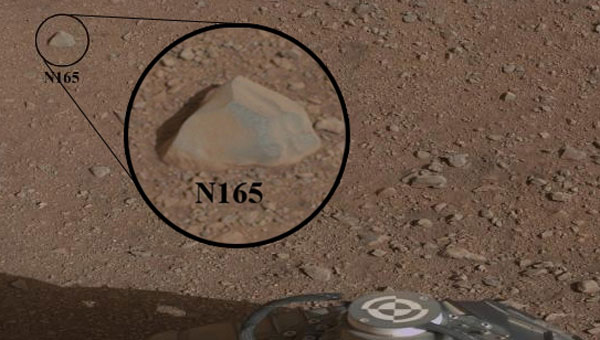Mars rover Curiosity zaps first Martian rock
Updated: 2012-08-20 10:40
(Agencies)
|
|||||||||||
 |
|
This mosaic image with a close-up inset, taken prior to the test, shows the rock chosen as the first target for NASA's Curiosity rover to zap with its Chemistry and Camera (ChemCam) instrument, on Mars in this Nasa handout photo. ChemCam fired its laser at the fist-sized rock, called "Coronation", with the purpose of analyzing the glowing, ionized gas, called plasma, that the laser excites. The test took place on August 19, 2012. [Photo/Agencies] |
LOS ANGELES - The Mars rover Curiosity zapped its first Martian rock on Sunday with a high-powered laser gun designed to analyze its mineral composition, and scientists declared their target practice a success.
The robotic science lab took aim at the fist-sized stone with its laser beam and shot the rock with 30 pulses over a 10-second period, NASA said in a statement issued from mission control at the Jet Propulsion Laboratory near Los Angeles.
Each pulse delivers more than 1 million watts of energy for about five one-billionths of a second, vaporizing a pinhead-sized bit of the rock to create a tiny spark, which is analyzed by a small telescope mounted on the instrument.
The ionized glow, which can be observed and recorded from up to 25 feet (7 meters) away, is then split into its component wavelengths by three spectrometers that give scientists information about the chemical makeup of the target rock.
The combined system, called the Chemistry-and-Camera instrument, or ChemCam, is designed to take about 14,000 measurements throughout Curiosity's mission on Mars.
The purpose of Sunday's initial use of the laser, conducted at roughly 3 am Pacific time (1100 GMT), was as "target practice" for the instrument. But scientists will examine the data they receive to determine composition of the rock, which they dubbed "Coronation," NASA said.
"We got a great spectrum of Coronation - lots of signal," said ChemCam principal investigator Roger Wiens of the Los Alamos National Laboratory in New Mexico, where the instrument was developed. "After eight years of building the instrument, it's payoff time."
Curiosity, a one-ton, six-wheeled vehicle the size of a compact car, landed inside a vast, ancient impact crater near Mars' equator on August 6 after an eight-month, 354-million-mile voyage through space. Its two-year mission is aimed at determining whether or not the planet most like Earth could have hosted microbial life.
The rover's primary target is Mount Sharp, a towering mound of layered rock rising from the floor of Gale Crater. But mission controllers are gradually checking out Curiosity's sophisticated array of instruments before sending it on its first road trip across the Martian landscape.
The $2.5 billion Curiosity project marks NASA's first astrobiology mission since the Viking probes to Mars during the 1970s and the most advanced robotic science lab sent to another world.
The technique employed by ChemCam has been used to examine the composition of materials in other extreme environments, such as inside nuclear reactors and on the sea floor.
The technology also has experimental applications in environmental monitoring and cancer detection. But Sunday's exercise, conducted during Curiosity's 13th full day on Mars, was the first use in interplanetary exploration, NASA said.
Related Stories
NASA completes 'brain transplant' on Curiosity 2012-08-15 12:23
NASA's Curiosity Rover on Mars 2012-08-08 14:09
NASA braces for "7 minutes of terror" Mars plunge 2012-08-06 11:09
NASA rover closing in on Mars to hunt for life clues 2012-07-30 11:07
Today's Top News
President Xi confident in recovery from quake
H7N9 update: 104 cases, 21 deaths
Telecom workers restore links
Coal mine blast kills 18 in Jilin
Intl scholarship puts China on the map
More bird flu patients discharged
Gold loses sheen, but still a safe bet
US 'turns blind eye to human rights'
Hot Topics
Lunar probe , China growth forecasts, Emission rules get tougher, China seen through 'colored lens', International board,
Editor's Picks

|

|

|

|

|

|





